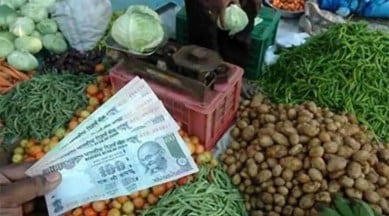Retail inflation rises to three-month high of 6.52% in Jan
Core inflation — non-food, non-fuel component — also remained sticky at 6.1 per cent in January, suggesting pricing power from the suppliers and manufacturers.

Retail inflation rose to a three-month high of 6.52 per cent in January, breaching the upper level of the medium-term 4+/-2 per cent target of the Reserve Bank of India (RBI) again, primarily due to increase in food inflation driven by higher prices of cereals and products, data released by the National Statistical Office (NSO) showed on Monday.
Core inflation — non-food, non-fuel component — also remained sticky at 6.1 per cent in January, suggesting pricing power from the suppliers and manufacturers.
monthly limit of free stories.
with an Express account.
The reversal of the moderation in inflation rate after remaining sub-6 per cent for two months came despite a 11.7 per cent decline in vegetable prices in January. This, experts said, increases the possibility of another rate hike by the Reserve Bank of India (RBI), adding that there is scope for the government to also consider further measures to ease wheat and fuel prices.
The retail inflation based on the Combined Price Index (Combined) had eased to a one-year low of 5.72 per cent in December. It had stood at 6.01 per cent in January 2022.
Combined food price inflation (CFPI) rose to 5.94 per cent in January from 4.19 per cent in December and 5.43 per cent in the year-ago period. Inflation rate for cereals and products increased to 16.12 per cent in January from 13.79 per cent a month ago, while inflation rate for meat and fish increased to 6.04 per cent from 5.13 per cent a month ago. Inflation rates for pulses and spices increased to 4.27 per cent and 21.09 per cent from 3.89 per cent and 20.35 per cent, respectively.
Clothing and footwear inflation eased to 9.08 per cent in January from 9.58 per cent a month ago, while fuel and light inflation rate moderated to 10.84 per cent from 10.97 per cent.
“The hope that retail inflation has fallen within the comfort zone of RBI and it would remain lower than the RBI’s upper tolerance band did not last more than two months…rise in food and beverage inflation has been across all commodity groups barring prepared oils and fats, sugar and confectionery, and fruits…government’s decision of 3 Million tonnes open market sale of wheat was targeted towards cooling off wheat prices. However, despite open market sale, the market prices haven’t cooled off…the wheat prices can cool off from here on due to a combination of (i) open market sale and (ii) higher wheat production than last year,” Sunil Kumar Sinha, Principal Economist, India Ratings said.
Inflation rate is expected to remain over 6 per cent for next two months and then moderate from March onwards, experts said.
“The RBI’s hawkish rhetoric was a surprise for the market last week, but its position has been validated. We see greater risks of another rate hike in April…volatility in India’s inflation in the last three months has been firmly driven by food prices, even as the pass through of falling energy prices has not yet fed through to India’s inflation numbers, both in motor fuel and cooking gas prices. We currently track February inflation at 6.3% yoy as cereal prices remain high, while transport and core inflation are sticky,” Rahul Bajoria, MD & Head of EM Asia (ex-China) Economics, Barclays said.The RBI in its latest monetary policy on February 8 had hiked the repo rate by 25 basis points. It had said that the outlook for inflation is mixed, projecting inflation at 6.5 per cent in 2022-23, with Q4 at 5.7 per cent. “While prospects for the rabi crop have improved, especially for wheat and oilseeds, risks from adverse weather events remain. The global commodity price outlook, including crude oil, is subject to uncertainties on demand prospects as well as from risks of supply disruptions due to geopolitical tensions. Commodity prices are expected to face upward pressures with the easing of COVID-related mobility restrictions in some parts of the world. The ongoing pass-through of input costs to output prices, especially in services, could continue to exert pressures on core inflation,” it had said.